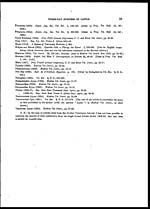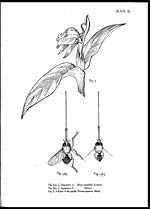Medicine - Veterinary > Veterinary colleges and laboratories > Indian journal of veterinary science and animal husbandry > Volume 1, 1931 > Part I (March 1931) > Notes on the bionomics and anatomy of Corizoneura longirostris, Hardwicke
(54) [Page24]
Download files
Individual page:
Thumbnail gallery: Grid view | List view
![(1) [Page24] -](https://deriv.nls.uk/dcn17/7522/75225958.17.jpg)
NOTES ON THE BIONOMICS AND ANATOMY OF CORIZONEURA LONGI-
ROSTRIS, HARDWICKE.
(DIPTERA: FAMILY TABANIDAE ; SUB-FAMILY PANGONINAE.)*
BY
S. K. SEN, M.Sc., F.E.S.,
Protozoologist, Imperial Institute of Veterinary Research, Muktesar-Kumaun.
|
CONTENTS. |
||||||||||
|
. |
. |
. |
. |
. |
. |
. |
. |
. |
PAGE |
|
|
NOTES ON IN THE BIONOMICS OF C. longirostris |
. |
. |
. |
. |
. |
. |
. |
. |
. |
25 |
|
NOTES ON THE ANATOMY OF C. longirostris |
. |
. |
. |
. |
. |
. |
. |
. |
. |
26 |
|
(a) THE MOUTH-PARTS |
. |
. |
. |
. |
. |
. |
. |
. |
. |
26 |
|
(b) THE REPRODUCTIVE TRACT |
. |
. |
. |
. |
. |
. |
. |
. |
. |
27 |
|
REFERENCES |
. |
. |
. |
. |
. |
. |
. |
. |
. |
28 |
Corizoneura, originally treated as a subgenus under Dialomineura (sub-family
Pangoninæ), was raised by Austen to generic rank in 1921, the genus Dialomineura,
Rond. (1864) itself having been shown by Brèthes (1914) to be a synonym of Osca,
Walk. (1850). In much of the earlier literature, flies of this class (characterized by
their conspicuously long proboscis) have been collectively referred to the genus
Pangonia, so that Hardwicke (1823), who founded the species which forms the
subject of this paper, described it as Pangonia longirostris.
Only two species of Corizoneura (including one variety) have been recorded
from the Indian Region. Senior-White [1927] gives the following synopsis for the
differential diagnosis of these :—
1. Proboscis much longer than the whole body .. .. 2.
Proboscis scarcely longer than the body ... laprobanes, Walk.
2. First two joints of front tarsi modified,
widened in both sexes ... ... longirostris, Hardw.
First two joints of front tarsi simple ... longirostris var. varipes, Ric.
Both the species would appear to be denizens of hilly tracts, a very notable
exception being a record of the occurrence of C. longirostris in Allahabad [Röder,
1881].** The almost exclusive occurrence of these species in the Hills doubtless
accounts for the remarkably few observations on record concerning their habits
*Being a paper read at the Zoological Section of the Indian Science Congress, Allahabad,
January 1930.
**It is, however, more than probable that this is an error.
Set display mode to: Large image | Zoom image | Transcription
Images and transcriptions on this page, including medium image downloads, may be used under the Creative Commons Attribution 4.0 International Licence unless otherwise stated. ![]()
| Permanent URL | https://digital.nls.uk/75225956 |
|---|
| Description | Covers articles from 1931. |
|---|




